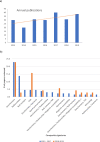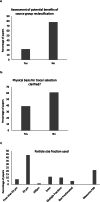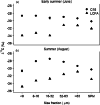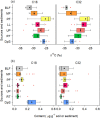Sediment source fingerprinting: benchmarking recent outputs, remaining challenges and emerging themes
- PMID: 33239964
- PMCID: PMC7679299
- DOI: 10.1007/s11368-020-02755-4
Sediment source fingerprinting: benchmarking recent outputs, remaining challenges and emerging themes
Abstract
Purpose: This review of sediment source fingerprinting assesses the current state-of-the-art, remaining challenges and emerging themes. It combines inputs from international scientists either with track records in the approach or with expertise relevant to progressing the science.
Methods: Web of Science and Google Scholar were used to review published papers spanning the period 2013-2019, inclusive, to confirm publication trends in quantities of papers by study area country and the types of tracers used. The most recent (2018-2019, inclusive) papers were also benchmarked using a methodological decision-tree published in 2017.
Scope: Areas requiring further research and international consensus on methodological detail are reviewed, and these comprise spatial variability in tracers and corresponding sampling implications for end-members, temporal variability in tracers and sampling implications for end-members and target sediment, tracer conservation and knowledge-based pre-selection, the physico-chemical basis for source discrimination and dissemination of fingerprinting results to stakeholders. Emerging themes are also discussed: novel tracers, concentration-dependence for biomarkers, combining sediment fingerprinting and age-dating, applications to sediment-bound pollutants, incorporation of supportive spatial information to augment discrimination and modelling, aeolian sediment source fingerprinting, integration with process-based models and development of open-access software tools for data processing.
Conclusions: The popularity of sediment source fingerprinting continues on an upward trend globally, but with this growth comes issues surrounding lack of standardisation and procedural diversity. Nonetheless, the last 2 years have also evidenced growing uptake of critical requirements for robust applications and this review is intended to signpost investigators, both old and new, towards these benchmarks and remaining research challenges for, and emerging options for different applications of, the fingerprinting approach.
Keywords: Biomarkers; Fingerprinting approach; Sediment-age dating; Tracers; Weathering indices.
© The Author(s) 2020.
Conflict of interest statement
Conflict of interestThe authors declare that they have no conflicts of interest.
Figures









Similar articles
-
Sediment source fingerprinting as an aid to catchment management: A review of the current state of knowledge and a methodological decision-tree for end-users.J Environ Manage. 2017 Jun 1;194:86-108. doi: 10.1016/j.jenvman.2016.09.075. Epub 2016 Oct 12. J Environ Manage. 2017. PMID: 27743830
-
Fingerprinting sub-basin spatial suspended sediment sources by combining geochemical tracers and weathering indices.Environ Sci Pollut Res Int. 2019 Sep;26(27):28401-28414. doi: 10.1007/s11356-019-06024-x. Epub 2019 Aug 2. Environ Sci Pollut Res Int. 2019. PMID: 31372955
-
The potential for colour to provide a robust alternative to high-cost sediment source fingerprinting: Assessment using eight catchments in England.Sci Total Environ. 2021 Oct 20;792:148416. doi: 10.1016/j.scitotenv.2021.148416. Epub 2021 Jun 15. Sci Total Environ. 2021. PMID: 34465054
-
Sediment source fingerprinting as an aid to large-scale landscape conservation and restoration: A review for the Mississippi River Basin.J Environ Manage. 2022 Dec 15;324:116260. doi: 10.1016/j.jenvman.2022.116260. Epub 2022 Sep 27. J Environ Manage. 2022. PMID: 36179467 Review.
-
Folic acid supplementation and malaria susceptibility and severity among people taking antifolate antimalarial drugs in endemic areas.Cochrane Database Syst Rev. 2022 Feb 1;2(2022):CD014217. doi: 10.1002/14651858.CD014217. Cochrane Database Syst Rev. 2022. PMID: 36321557 Free PMC article.
Cited by
-
Using lake sediments to assess the long-term impacts of anthropogenic activity in tropical river deltas.Anthropocene Rev. 2024 Aug;11(2):442-462. doi: 10.1177/20530196231204334. Epub 2023 Oct 9. Anthropocene Rev. 2024. PMID: 39156121 Free PMC article. Review.
-
Determination of sediment sources following a major wildfire and evaluation of the use of color properties and polycyclic aromatic hydrocarbons (PAHs) as tracers.J Soils Sediments. 2023;23(12):4187-4207. doi: 10.1007/s11368-023-03565-0. Epub 2023 Jul 4. J Soils Sediments. 2023. PMID: 38037661 Free PMC article.
-
Fingerprinting the spatial sources of fine-grained sediment deposited in the bed of the Mehran River, southern Iran.Sci Rep. 2022 Mar 10;12(1):3880. doi: 10.1038/s41598-022-07882-1. Sci Rep. 2022. PMID: 35273258 Free PMC article.
-
Mapping wind erosion hazard with regression-based machine learning algorithms.Sci Rep. 2020 Nov 24;10(1):20494. doi: 10.1038/s41598-020-77567-0. Sci Rep. 2020. PMID: 33235269 Free PMC article.
-
The representation of sediment source group tracer distributions in Monte Carlo uncertainty routines for fingerprinting: An analysis of accuracy and precision using data for four contrasting catchments.Hydrol Process. 2020 May 30;34(11):2381-2400. doi: 10.1002/hyp.13736. Epub 2020 Mar 10. Hydrol Process. 2020. PMID: 32612321 Free PMC article.
References
-
- Alewell C, Birkholz A, Meusburger K, Wildhaber YS, Mabit L. Quantitative sediment source attribution with compound-specific isotope analysis in a C3 plant-dominated catchment (central Switzerland) Biogeosciences. 2016;13:1587–1596.
-
- Appleby PG. Chronostratigraphic techniques in recent sediments. In: Last WM, Smol JP, editors. Tracking environmental change using lake sediments volume 1: basin analysis, coring, and chronological techniques. Dordrecht: Kluwer Academic Publishers; 2001. pp. 171–203.
-
- Appleby PG, Richardson N, Nolan PJ. 241AM dating of lake-sediments. Hydrobiologia. 1991;214:35–42.
-
- Appleby PG, Semertzidou P, Piliposian GT, Chiverrell RC, Schillereff DN, Warburton J. The transport and mass balance of fallout radionuclides in Brotherswater, Cumbria (UK) J Paleolimnol. 2019;62:389–407.
-
- Arnaud F, Magand O, Chapron E, Bertrand S, Boes X, Charlet F, Melieres MA. Radionuclide dating (Pb-210, Cs-137, Am-241) of recent lake sediments in a highly active geodynamic setting (Lakes Puyehue and Icalma-Chilean Lake District) Sci Total Environ. 2006;366:837–850. - PubMed
Grants and funding
LinkOut - more resources
Full Text Sources
